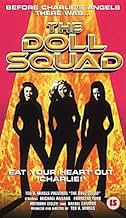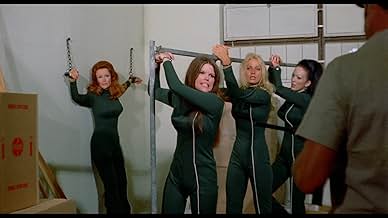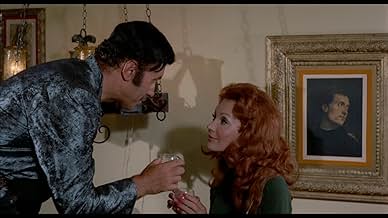IMDb RATING
4.4/10
1.2K
YOUR RATING
Squad of beautiful government agents tries to catch saboteurs.Squad of beautiful government agents tries to catch saboteurs.Squad of beautiful government agents tries to catch saboteurs.
- Director
- Writers
- Stars
Herb Robins
- Munson
- (as Herb Robbins)
Gustaf Unger
- Dr. Cahaymen
- (as Gustave Unger)
- Director
- Writers
- All cast & crew
- Production, box office & more at IMDbPro
Featured reviews
Director Mikels claims this was the inspiration for "Charlie's Angels." Maybe so or maybe not, but this film turns out to be a fairly standard 3 girl/4 girl formula exploitation acioner. Some funny scenes, like the exploding enemy agents. Satana is wasted in a supporting role. This one probably satisfied the drive in crowd in 1973, but it doesn't have too much to recommend it now, even to fans (like me) of this stuff, because it's a bit too clunky.
'The Doll Squad' is testimony to Ted V. Mikel's complete lack of talent, in that he can take the idea of a team of beautiful assassins who must save the world from an evil mastermind intent on infecting us all with bubonic plague, and make it COMPLETELY BORING. On paper this looks like it could be a wonderfully trashy and camp 1970s experience, the kind of movie parodied with such skill and fun in the Austin Powers series. Actually trying to sit through it and stay awake is another matter! Mikel's woeful direction, the no-budget special effects, and the awful acting throughout make it almost painful to endure. Even the semi-naked appearance of the legendary Tura Satana ( from Russ Meyer's classic 'Faster Pussycat!') can't save this turkey!
Ted V Mikels is a kitsch director whose best work rises above practical efforts at criticism. He produced the films most highly regarded amongst a coterie of fans over just few years: The Astro Zombies' (1969), The Corpse Grinders' (1972), and Blood Orgy of The She Devils' (1972), each have their following and have endured on video. As the last of Mikel's trash favourites to appear, 'The Doll Squad' contains the least horror and fantasy and, in comparison to it's predecessors, adheres more closely to a logical dramatic structure. Since then, although he had remained active - most recently with Dimension of Fear' (1998) - Mikels has produced nothing else regarded by fans with such long-lived affection. Firmly in the realms of so-bad-it's-good, the years have added an enjoyable sheen to The Doll Squad', particularly now that it can be taken with the gloss of post-modern irony.
This is the film whose central premise - Mikels allegedly claimed - was ripped off by producer Aron Spelling to become the television series Charlie's Angels'. No doubt the reissue of Doll Squad' has also been at least in part inspired by the commercial success and marketing of the big screen version of that programme. Comparison of Mikels' film with Spelling's work does reveal similarities. But nothing in the TV Charlie's Angels', or the recent Hollywood outing compares to Mikel's wide-eyed glance at the genre, the cheesy pulchritude on display and his disregard for dramatic standards.
The Doll Squad is selected for assignment by computer, after it picks up 'something in O'Riley's personality which means experienced women should do the job' of stopping him. 'Experience' in this context naturally implies more than just familiarity with tough assignments. The squad of Sabrina, Liz, Sharon, Lavelle and Kim hail from different backgrounds, including a librarian, a scientist, karate instructor and, most noticeably, erotic dancer (played by Tura Satana, the Apache-Japanese better known for her role in Russ Meyer's far more provocative 'Faster Pussy Cat, Kill Kill!' (1965)).
It might be argued that, as a group of strong assertive women, the Doll Squad is a model of feminine self-reliance. After all, they are empowered to find and stop the villainous O'Riley by a senator, and are allowed complete independence and licence for the duration of their mission. But their assertiveness is essentially apolitical and, except for their expected impact on the criminal community, always non-threatening and contained within fantasy. The choice of squad personnel, obviously intended as a cross section of female society, merely emphasises a common voluptuousness. In tandem with the women's physical stamina, Mikel creates through this all-too familiar trash archetypes
Leaving aside its relationship to 'Charlie's Angels', the most striking element of Mikels' film is its flat playfulness. Like most favourite cult trash directors, he is cheerfully oblivious to the handicaps of abilities and material. For the viewer, of course this is part of the fun. It would be pointless here to refer in detail to the fluffed lines, one-dimensional plot and rudimentary cutting and pacing. Instead, a viewer best engages with the film on a naïve level, such (presumably) as the director/producer/co writer did, or by assuming a knowing camp sophistication. There's more than a degree of that to be found in the flame-thrower cigarette lighter, for instance, the lame kung fu, or the exploding poison. These days The Doll Squad' is more likely to leave the knowing viewer with a wink than a grimace, as it plays its simple variation on the espionage thriller. As a z-grade auteur, Mikels, resolutely goes his own way in the film, immune to the strictures of any responsible' judgement, incidentally striking a chord with the modern viewer which he could hardly had anticipated at the time.
However one approaches the film, it still has the distinct straight-faced charm which has kept it a favourite down the years. Helped by a surprisingly strong musical score, and photographed competantly, The Doll Squad', beehive hair cuts and cheesy décor intact, has dated pleasantly and remains a guilty pleasure.
This is the film whose central premise - Mikels allegedly claimed - was ripped off by producer Aron Spelling to become the television series Charlie's Angels'. No doubt the reissue of Doll Squad' has also been at least in part inspired by the commercial success and marketing of the big screen version of that programme. Comparison of Mikels' film with Spelling's work does reveal similarities. But nothing in the TV Charlie's Angels', or the recent Hollywood outing compares to Mikel's wide-eyed glance at the genre, the cheesy pulchritude on display and his disregard for dramatic standards.
The Doll Squad is selected for assignment by computer, after it picks up 'something in O'Riley's personality which means experienced women should do the job' of stopping him. 'Experience' in this context naturally implies more than just familiarity with tough assignments. The squad of Sabrina, Liz, Sharon, Lavelle and Kim hail from different backgrounds, including a librarian, a scientist, karate instructor and, most noticeably, erotic dancer (played by Tura Satana, the Apache-Japanese better known for her role in Russ Meyer's far more provocative 'Faster Pussy Cat, Kill Kill!' (1965)).
It might be argued that, as a group of strong assertive women, the Doll Squad is a model of feminine self-reliance. After all, they are empowered to find and stop the villainous O'Riley by a senator, and are allowed complete independence and licence for the duration of their mission. But their assertiveness is essentially apolitical and, except for their expected impact on the criminal community, always non-threatening and contained within fantasy. The choice of squad personnel, obviously intended as a cross section of female society, merely emphasises a common voluptuousness. In tandem with the women's physical stamina, Mikel creates through this all-too familiar trash archetypes
Leaving aside its relationship to 'Charlie's Angels', the most striking element of Mikels' film is its flat playfulness. Like most favourite cult trash directors, he is cheerfully oblivious to the handicaps of abilities and material. For the viewer, of course this is part of the fun. It would be pointless here to refer in detail to the fluffed lines, one-dimensional plot and rudimentary cutting and pacing. Instead, a viewer best engages with the film on a naïve level, such (presumably) as the director/producer/co writer did, or by assuming a knowing camp sophistication. There's more than a degree of that to be found in the flame-thrower cigarette lighter, for instance, the lame kung fu, or the exploding poison. These days The Doll Squad' is more likely to leave the knowing viewer with a wink than a grimace, as it plays its simple variation on the espionage thriller. As a z-grade auteur, Mikels, resolutely goes his own way in the film, immune to the strictures of any responsible' judgement, incidentally striking a chord with the modern viewer which he could hardly had anticipated at the time.
However one approaches the film, it still has the distinct straight-faced charm which has kept it a favourite down the years. Helped by a surprisingly strong musical score, and photographed competantly, The Doll Squad', beehive hair cuts and cheesy décor intact, has dated pleasantly and remains a guilty pleasure.
MASTER PLAN: blow up rockets, get a microfilm and spread a bubonic plague - whew, the villain is busy in this one. Though a fan of seventies cinema, I've missed seeing this film until now and it really does seem like an earlier version of "Charlie's Angels," beating the TV series to the screen by a few years. But, this is much more violent compared to that safe TV style; in fact, there's also more of that seventies brutality here when comparing this to the James Bond films, the other franchise this movie sort of emulates. Neither side in this film, meaning the good gals and the bad guys, messes around. In an early sequence of scenes, the villain (Ansara) sends some assassins for a preemptive strike against the squad; one assassin shoots a squad member twice in the head at point blank range and still checks to make sure she's dead. Meanwhile, the Dolls deal with the villain's guards by having them swallow pills which literally make them explode. The squad's leader avoids her own assassination in a particularly heated fashion. These babes are brutal, in that cheap thrill sort of way, and terming them as a 'Doll Squad' is actually a bit insulting.
Most of the complaints about this film have to do with it being dull and, yes, there are a few slow spots, but, despite the obviously cheap quality of this Bond-wannabe, it's surprisingly entertaining. Just as in the first Flint film "Our Man Flint," a computer selects the ideal agents for the mission, requested by a senator & intelligence supervisor (Eisley); this also reminded me of the "Mission:Impossible" TV series. There had been other female Bond films, such as "Modesty Blaise;" this one presents a whole team. Most of the plot involves their plans to raid the villain's stronghold where, in the tradition of villains with unlimited funds, he employs his own private army. The last third is the actual attack, and there's much gunplay and karate chopping, not to mention explosions matted in optically (real explosions were probably too expensive, but there's a certain charm to these FX). The squad leader (York) has a personal history with the villain, who delays killing her because of this. York is pretty good in the role, not just a talentless bimbo, while Ansara excelled in these melodramatic larger-than-life roles. This also features a unique film appearance by Satana, who became a cult star in "Faster Pussycat..Kill!Kill!" but appeared in very few movies afterward. The climax even resembled the climactic action of "The Dirty Dozen" - femme fatale style, of course. Heroines:6 Villain:6 Male Fatales:5 Henchmen:5 Fights:5 Stunts/Chases:4 Gadgets:3 Auto:3 Locations:3 Pace:4 overall:4+
Most of the complaints about this film have to do with it being dull and, yes, there are a few slow spots, but, despite the obviously cheap quality of this Bond-wannabe, it's surprisingly entertaining. Just as in the first Flint film "Our Man Flint," a computer selects the ideal agents for the mission, requested by a senator & intelligence supervisor (Eisley); this also reminded me of the "Mission:Impossible" TV series. There had been other female Bond films, such as "Modesty Blaise;" this one presents a whole team. Most of the plot involves their plans to raid the villain's stronghold where, in the tradition of villains with unlimited funds, he employs his own private army. The last third is the actual attack, and there's much gunplay and karate chopping, not to mention explosions matted in optically (real explosions were probably too expensive, but there's a certain charm to these FX). The squad leader (York) has a personal history with the villain, who delays killing her because of this. York is pretty good in the role, not just a talentless bimbo, while Ansara excelled in these melodramatic larger-than-life roles. This also features a unique film appearance by Satana, who became a cult star in "Faster Pussycat..Kill!Kill!" but appeared in very few movies afterward. The climax even resembled the climactic action of "The Dirty Dozen" - femme fatale style, of course. Heroines:6 Villain:6 Male Fatales:5 Henchmen:5 Fights:5 Stunts/Chases:4 Gadgets:3 Auto:3 Locations:3 Pace:4 overall:4+
The only other Ted V. Mikels film I had seen before this is "Blood Orgy of the She-Devils". And the only thing I remember about it is that it was completely awful. Thankfully, "The Doll Squad" is considerably better. It is crudely directed, with often poor continuity and laughable "special effects" (low points: the fake explosions). But it is also ahead of its time: how many films do you suppose had been made before 1973 featuring female commandos using guns, explosives and martial arts to wipe out small armies of bad men? Not many, that's for sure. Whether dressed in their bikinis or in their tight, form-fitting uniforms, the women in this film look good, and handle their basic action scenes fairly well. So "The Doll Squad" may not be art (far from it, in fact), but from a female action cinema fan's perspective, it delivers where it counts. (**)
Did you know
- TriviaIt is speculated that Aaron Spelling got the idea for Drôles de dames (1976) after attending the premier of this film.
- GoofsThe finale of the film supposedly takes place on a remote island off the coast of South America, yet the vehicles driven by the bad guys bear Montana license plates.
- Alternate versionsThe film was originally shown in two versions, both possibly uncut, with different posters aiming at different markets: The Doll Squad, rated PG, distributed by Geneni Film; and Seduce and Destroy, rated R, by Dinero Productions.
- ConnectionsFeatured in The Wild World of Ted V. Mikels (2008)
- How long is The Doll Squad?Powered by Alexa
Details
- Release date
- Country of origin
- Language
- Also known as
- Anti-Gang et Séduction
- Filming locations
- Glendale, California, USA(Compound)
- Production company
- See more company credits at IMDbPro
Contribute to this page
Suggest an edit or add missing content
















